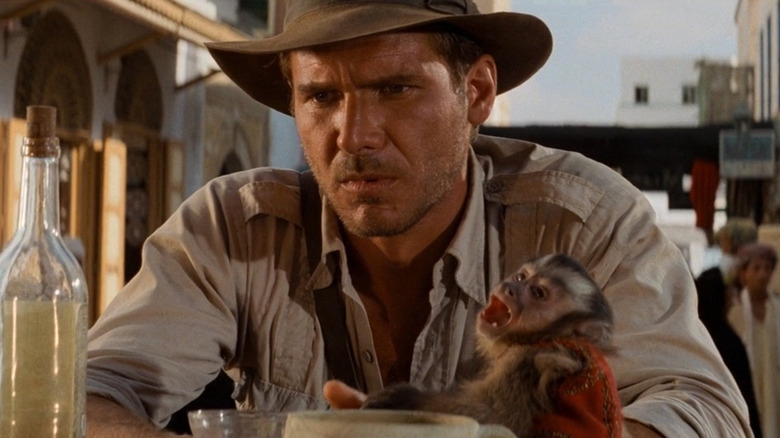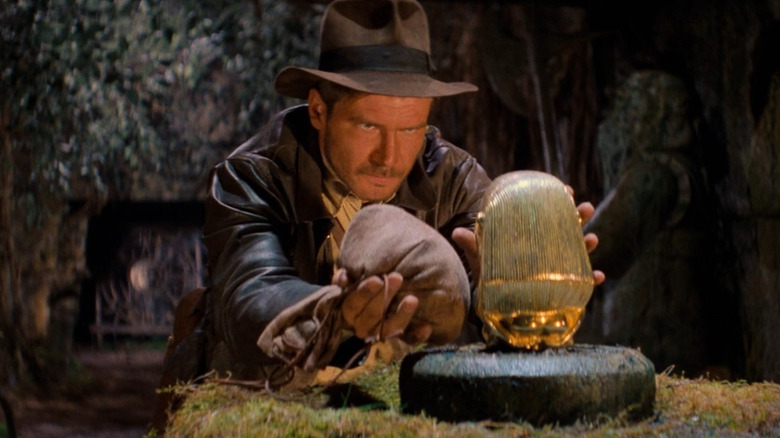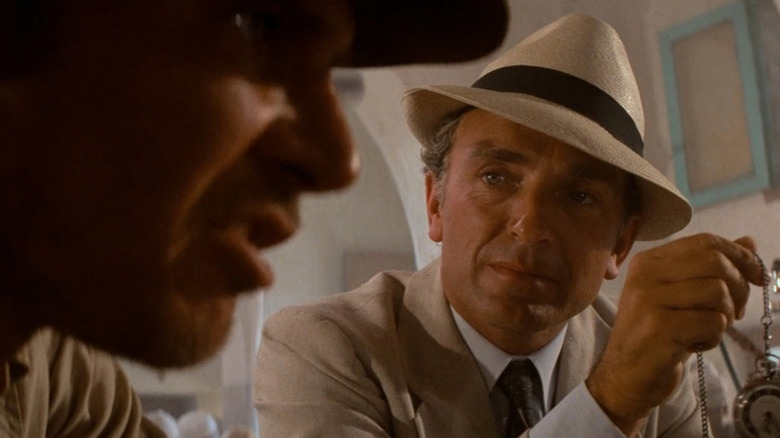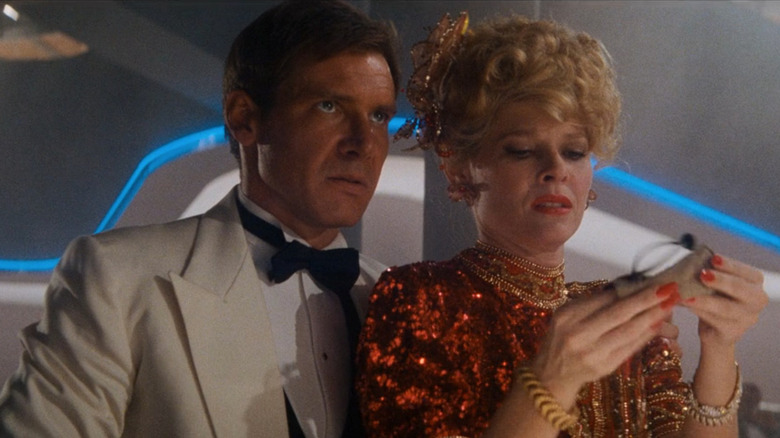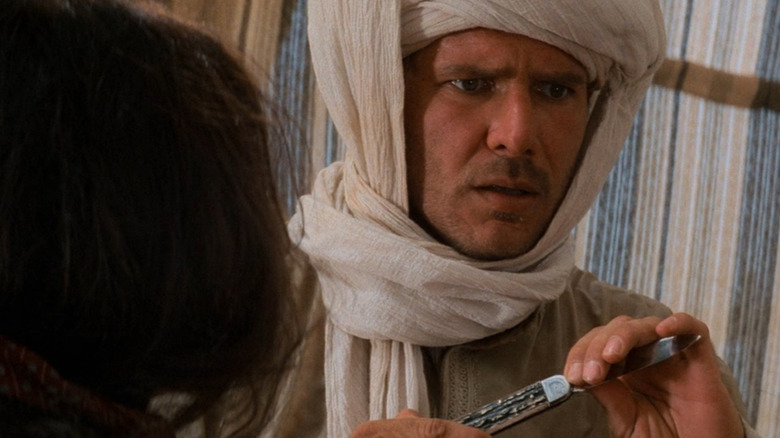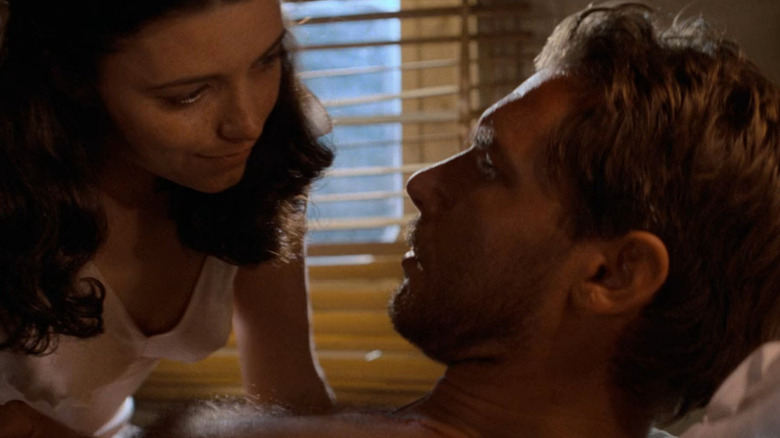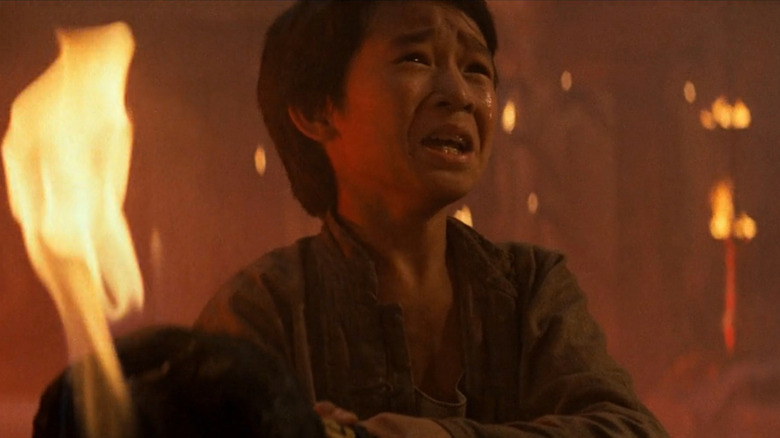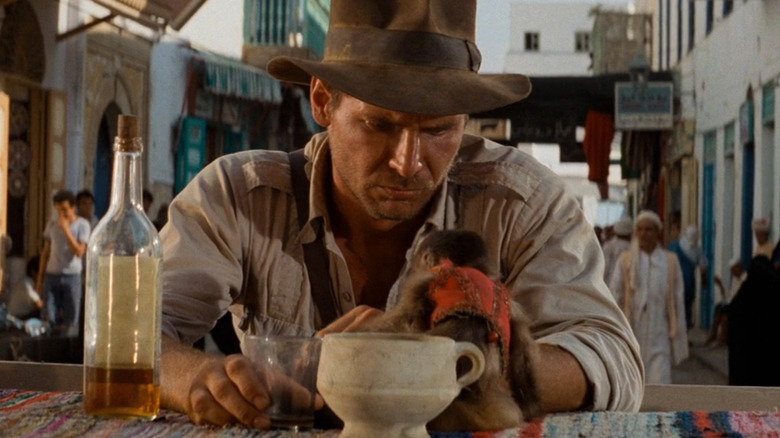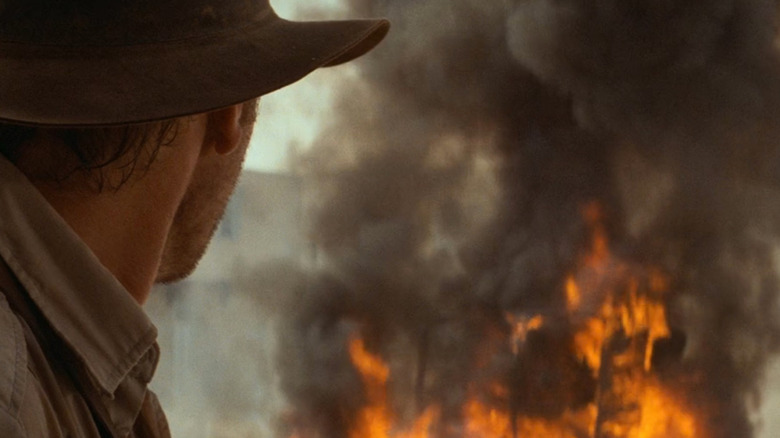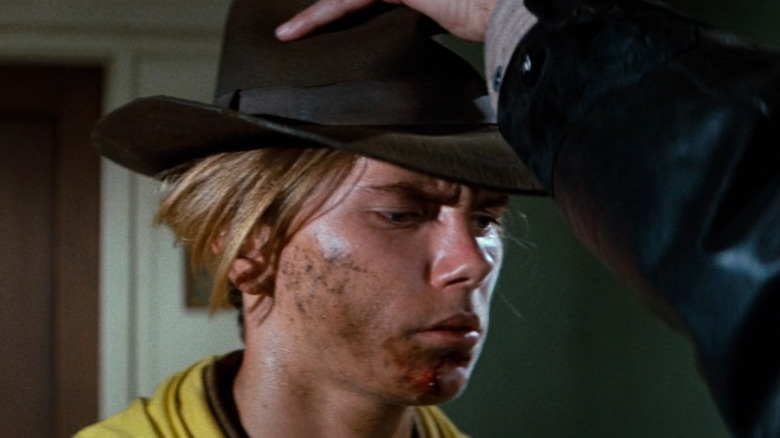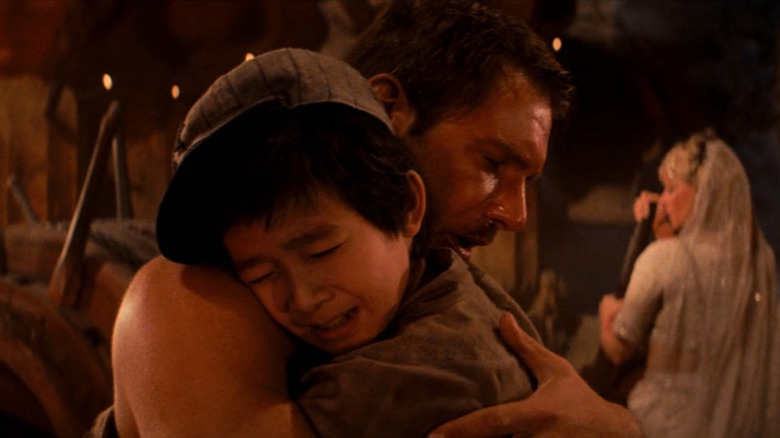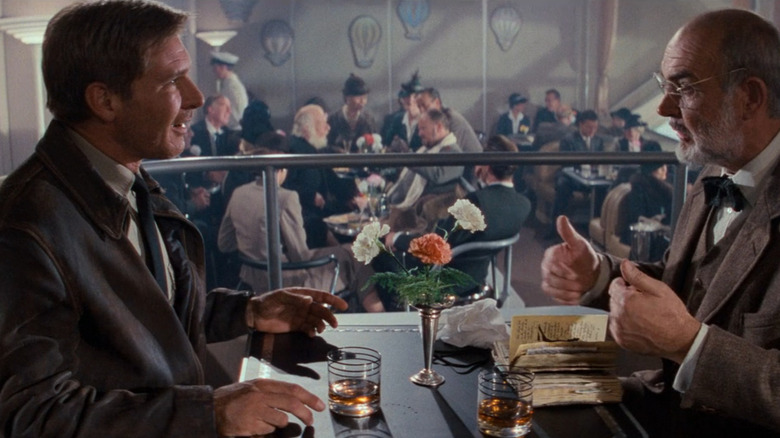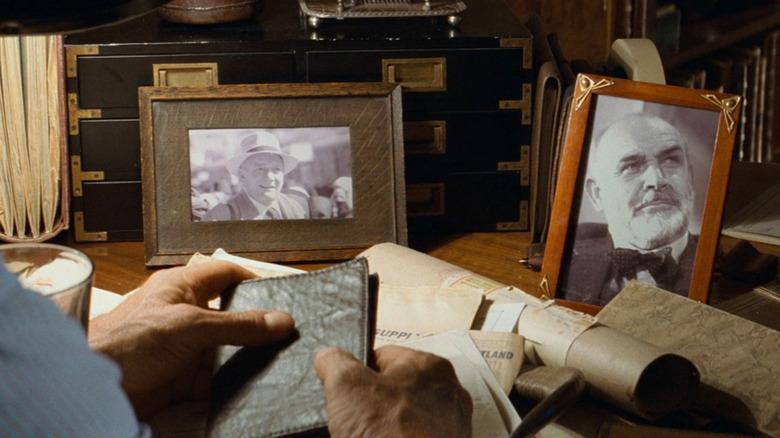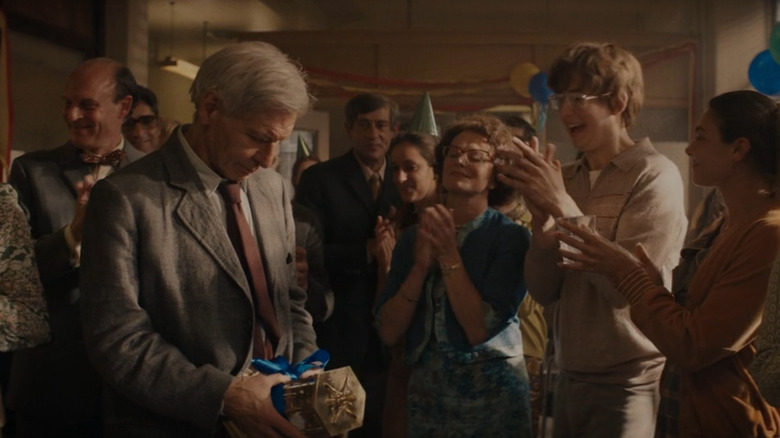Why Indiana Jones Is Actually The Villain Of The Franchise
Indiana Jones is a professor of archaeology, an expert on the occult, an obtainer of rare antiquities, and — how does one say it — a bad guy? The "Indiana Jones" films are cinematic thrill rides full of iconic movie moments starring an equally iconic "hero" who is anything but a knight in shining armor. In fact, he's as likely to steal that armor and sell it to a museum as he is to do a good deed in it.
Inspired by the action-adventure serials of the 1930s, Indy was first brought to life in 1981's "Raiders of the Lost Ark" by George Lucas, Stephen Spielberg, and Lawrence Kasdan. While Indy punches Nazis with aplomb and saves the day as much as he saves history, he's also a selfish jerk, a sloppy thief, a callous partner, a cynical professor, a total heartbreaker, a menace to public markets — we could go on, at length. And, just like the mine cart chase in "Temple of Doom," we will.
But before you crack the nearest bull-whip in fury, know that while Indiana Jones might be a baddie, he is a beloved one. So take the leap, pierce the veil of nostalgia and peer into the cavern of truth. Read on to discover why Indy is the villain of his own film franchise — and why that might not necessarily be a bad thing.
Indiana Jones and the callous cash grabs
In "Raiders of the Lost Ark," the first "Indiana Jones" film, Indy is a past profiteer. A professional looter, plain and simple. He regularly goes on adventures and sells the precious artifacts he brings back to museums, mostly through his friend and colleague Marcus Brody. While reckless greed isn't the motivation for Indy's artifact-obtaining sideline, world travel and epic adventure must set a professor like Indy back a pretty penny, even in the 1930s.
René Belloq, the elegantly evil villain in "Raiders," isn't merely happy to settle for "good" sums like Indy. Instead, he works for the highest bidder — Hitler. While Indy expresses distaste for Belloq's decision to work with the Nazis in the name of archaeology, our protagonist doesn't extend the same scrutiny to his own practice. Indy pays no heed to the rightful, ancestral owners of the items he plunders.
While the early "Indiana Jones" films are undeniably racist in their depictions of the locals Indy works with and against, especially "Raiders" and "Temple of Doom," Indy himself is also culturally insensitive in his colonial short-sightedness. In "Raiders," Indy clearly believes that the ancient artifacts he steals belong in museums, and the price they command ("no questions asked") belongs in his pocket.
Indiana Jones and the corrupted cause
If anyone recognizes the villainous qualities in Indiana Jones, it's the main antagonist of "Raider of the Lost Ark," Dr. René Belloq. They're both in the artifact-selling business, even if Belloq manages more black-market deals than Indy. The film implies that Indy was once devoted to his thirst for knowledge. He had a sense of historical stewardship that he satisfied with archaeology, but now, he is a lot closer to Belloq than he would care to admit.
"Archaeology is our religion, yet we have both fallen from the purer faith," Belloq tells Indy. "Our methods have not differed as much as you pretend. I am a shadowy reflection of you. It would take only a nudge to make you like me, to push you out of the light." What makes Belloq's speech so horrible is how true it is. Even though Indy is obsessed with retrieving the Ark and wants it to end up in a museum, he lacks any apparent deeper desire to understand it. It could just be the nuance of Paul Freeman's performance, but Belloq seems reverent of the Ark. He seems to treat working for Hitler as a means to an end to finally behold the "radio for speaking to God."
Of course, Belloq literally melts his own face off when he does use the Ark. Still, it's remarkable how much belief and conviction he has compared to Indy in "Raiders." Indy fights Nazis incidentally, not ideologically — he punches any face in between him and his quarry, with no particular passion behind his actions. Belloq sees this, and he sees that Indy is entering his villain era.
Indiana Jones and the heartbreak hotel
Indiana Jones isn't content to just steal priceless artifacts from a variety of temples, pedestals, and all manner of critter-infested pits — he also steals plenty of hearts along the way. Indy goes through love interests like he does busy marketplaces: With attitude and reckless abandon.
Sometimes Indy begrudgingly respects his partners (Marion), but sometimes he leaves them at the altar (Marion). Sometimes he kisses them in a way that makes audiences cheer (Marion and Willie) and children roll their eyes (Marion and Willie). But he always sasses them, gaslights them, and cuts and runs on whoever has grown to love him.
Indy's instinct to flee emotional intimacy at moments of commitment is peak villain behavior. While his emotional withdrawal from lovers, friends, and family is played for heroic strength (and even laughs) in the early "Indiana Jones" films, this avoidance and self-reliance later comes back to haunt him in "Dial of Destiny."
Indiana Jones and the one-track mind
Indiana Jones is obsessed with hunting down artifacts, and he doesn't care what stands in his way — even when he should. Indy is initially so focused on attaining "fortune and glory" via glorified grave-robbing that he engages in sloppy and selfish archaeological practices. Indy regularly (and callously) threatens present life and precious history all around him, all for the sake of his quests.
First up, the human price of villainous focus: Indy passes on an opportunity to rescue Marion from Belloq in "Raiders" because he thinks doing so will mess up his chances at getting the Ark. "Dial of Destiny" reexamines a lot of Indy's past misdeeds, but also shows that bad habits die hard. Instead of going to rescue young Teddy, Indy tells Helena that Schmidt and his goons won't hurt Teddy, and that they'll just use him to get to Archimedes' tomb — so instead of saving the kid, Indy and Helena go for the gold.
Indy also flies by the seat of his khaki pants when it comes to entering and escaping the graves he robs. He uses corpses as torchlights, regularly destroys his archaeological sites, and he can't keep a skeleton intact to save his life — unless he's restoring the skull of a possible alien overlord, that is. When Indy keeps his eyes only on the prize, his villainous tendencies are on full display.
Indiana Jones and the bad romance
Indiana Jones began his relationship with Marion Ravenwood with what seems to be a literal crime. Canonically, Indy first "romanced" young Marion when he was in his mid-20s and she was around 16 years old. Actor Karen Allen clarified to Uproxx that she thinks the relationship was "innocent." Still, when Marion's dad, archaeologist Abner Ravenwood, discovered the affair, he kicked Indy off the initial search for the Ark of the Covenant.
Marion is fully aware of how Indy wronged her when she meets up with him again in her twenties to continue the search for the Ark in "Raiders." Indy is cruel about her rage and heartache, telling her, "I can only say I'm sorry so many times." He asks Marion for an amulet to help him search for the ark, but fails to warn her about the Nazis hot on his tail. Nazis who attack Marion and burn her bar to the ground. First Indy broke her heart, then he broke her place of business. What a guy!
Indy and Marion go on to rekindle their romance, which ultimately lasts throughout the franchise, despite the small fact that Indy left Marion at the altar sometime after the end of "Raiders." There is also the matter of Indy's instant, raging jealousy and bratty behavior whenever Marion speaks of another man — even if said man is her literal captor, like Belloq.
Indiana Jones and the abandonment issues
Indiana Jones isn't above cutting ties with friends and colleagues after he's gotten what he needs from them — at least, until they become useful again. Perhaps the most obvious example is Indy inexplicably abandoning his little buddy Short Round (Ke Huy Quan), never to be seen again (not including offscreen comic book appearances).
Indy drops contact with his father, only to reunite with him for a job in "Last Crusade." He ignores the letters of his fellow archaeologist Baz Shaw in "Dial of Destiny," finding Baz's obsessive correspondence about the dial obnoxious and off-putting. By ignoring Baz, Indy also cuts off his relationship with his goddaughter Wombat at a young age — only to meet her again, many years later, after Baz is dead and gone.
Only after Indy and Helena start hunting for the dial does he realize that his old friend's letters weren't mad ramblings, but — much like his father's journals and the walls of Harold Oxley's cell in "Kingdom of the Crystal Skull" — directions to discover a precious truth. A villain often thinks he knows best. Indiana Jones does exactly that, but, unlike most villains, Indy eventually learns that acting like he alone knows best comes at too high a price.
Indiana Jones and the lack of impulse control
Villains don't play by anyone's rules but their own, and Indiana Jones is no different. He famously brings a gun to what's supposed to be a sword fight in "Raiders," gunning a blade-wielding man down without a second thought. Also in "Raiders," Indy shoots the cart he believes is carrying Marion without once considering if it might be packed with explosives. The "hero" is truly shocked when he blows the whole cart up with a single shot, instantly killing Marion — or so he thinks.
Indy adds insult to injury when he befriends the monkey who helped the villains give chase to Marion, becoming drinking buddies with an animal who indirectly killed his girlfriend. Also, in order to show up mob boss Lao Che in "Temple of Doom," Indy makes a snap decision to threaten his singer girlfriend, Willie. Indy's attempt to use somebody else's girlfriend as leverage leads to him accidentally bringing her along on his next adventure, essentially kidnapping her.
Indiana Jones and the flagrant disregard for people's property
If you run a market stall in a country with precious relics, Indiana Jones is not your friend. In fact, he's your worst enemy. No melon cart is safe from this man. No woven basket can escape intact. No tower of oranges will meet Indiana Jones and live to tell the tale. And his destructive streak doesn't stop there.
If there is a military vehicle or quaint tourist boat anywhere near Indiana Jones and he's in the middle of a quest, chances are that vehicle will be thoroughly destroyed within the hour. Should your local library, church, or library-church contain the secret tomb of a knight with an artifact clutched to his decaying breast? We're sorry. Start the fundraiser for a new one now.
Tanks, planes, temples, subways, horses, camels, the ocean floor, circus trains, plunder trains, mining trains, and — quite possibly — alien ships. If wrecking it gets Indy an inch closer to where he needs to be, he won't think twice about it. This list is far from complete, but it's enough to show that this archaeologist doesn't care about anyone else's property.
Indiana Jones and the villain origin story
Indiana Jones grew up in a lonely household shared with this obsessive academic father. After Indy's mother died, all he had was his dismissive father and the great outdoors. Indy's villain origin story comes out of this lonely setting.
In "Last Crusade," viewers get a glimpse of the young Indiana Jones (River Phoenix) being explicitly told by a scout leader not to venture off the trail. Of course, Indy does just that and he discovers a pack of grave robbers stealing the precious Cross of Coronado. While the thieves are plundering for profit, young Indy is moved to steal the cross for its rightful home — the museum. Indy battles the men — and a circus car full of snakes — to steal the cross back.
With the artifact in hand, Indy runs to the authorities, who are in on the scam. Indy loses both the cross and his father's patience. What's interesting is that Indy steals his signature fedora-topped look from the dirtbag leader of the plunder gang. This band of thieves clearly inspires Indy's life of "crime" just as much as his pure love for archaeology ever does.
The Temple of Doom plants the seeds of change
"Indiana Jones and the Temple of Doom" is a turning point for our villainous hero, and for the Indiana Jones franchise. On one hand, the film is a damning display of the outright racism, exoticism, and misogyny that mainstream popcorn cinema could get away with in 1984. On the other, "Temple" helped give Indiana Jones back his heart — even if it had to rip out a few more in the process.
"Temple" is the second movie in the franchise, but it's set before the events of "Raiders." While the film itself is culturally insensitive to the max, Indy as a character is not. In this film, he learns the languages and customs of the communities he's working with. He returns their stolen artifacts to them rather than sending them off to gather dust in a Western museum. And, most importantly, the movie shows that, when push comes to shove, Indy cares more about saving kids and other innocents than he does about fortune and glory.
Indy may be the "hero" of "Raiders," but in "Temple" he becomes truly heroic — even if (especially if) he didn't set out to be. "Temple" also starts a tradition of evolving the closed-off, cruel character of Indiana Jones presented in "Raiders." This revisionist history allows room for a more heartfelt and heroic Indiana Jones. The result makes Indy a much more relatable character, even if he does become somewhat embittered and cynical between the events of "Temple" and "Raiders."
The Last Crusade shows Indy's sensitive side
If "Raiders" presented a rough and tumble Indiana Jones with an emphasis on the rough, 1989's "Last Crusade" brought in Indy's more sensitive side. The movie presses on the bruises of Indy's relationship with his also-isolated father. While Dr. Henry Jones Sr. (Sean Connery) has a surface-level relationship with his son, their reunion as adults has Indy longing for something more, even if his dad can be "intolerable" at times.
Indy confesses that his father's obsessions made life lonely growing up, and his dad quite literally mocks his pain. We can see where Indy gets a lot of his villainous qualities from — but also, his tenacity and genuine love of history. The movie shows the pure conviction young Indy had in his quest for knowledge, and instead of making adult Indy's character corny or bitter, we see how he's actually very nuanced.
"Last Crusade" also solidifies Indy's ideological opposition to the Nazis, rather than casting them as an occupational hazard when it comes to obtaining antiquities. The longer Indy's journey becomes through the sequels to "Raiders," the deeper his character is allowed to be. The hotshot hero is revealed to be very human, very complex, and less selfish.
The Kingdom of the Crystal Skull has Indy in a reflective mood
"Indiana Jones and the Kingdom of the Crystal Skull" came out in 2008, 19 years after "Indiana Jones and the Last Crusade." The titular character has changed over the course of almost two decades, and he's grown a whole lot more by the time the credits roll on the fourth installment in the franchise. He's more comfortable teaching, he's pretty much blown up Area 51, he's survived a little nuclear attack, he's discovered he's a father and gotten back together with Marion. Aside from the whole nuke survival thing, he seems almost average, with way fewer villainous tendencies than he had in years gone by.
These are the kinds of changes that come with age. When FBI interest causes a shake-up at work, Indy's colleague Charles Stanforth (Jim Broadbent) advises that the FBI has put him on a paid leave of absence. Indy shoots his mouth off, disgusted by the offer of the FBI's money — until he learns that in order to get such a pay-off, Stanforth resigned from his own beloved job. Indy softens, and further bonds with Stanforth while looking at photos of his father and Marcus Brody. "We seem to have reached the age where life stops giving us things and starts taking them away," Stanforth says. Indy's sad look says it all — his concern is not for fortune and glory anymore, but for other treasures entirely.
The Dial of Destiny proves that anyone can change
When "Indiana Jones and the Dial of Destiny" hit cineplexes in 2023, Harrison Ford was 80 years old. The star is de-aged for a thrilling 25-minute Nazi-fighting sequence in the fifth "Indiana Jones" movie, but he spends the majority of it as an older gentleman — emphasis on the gentleman. While he still has some of his signature attitude, the Indy we see here is a world away from the one introduced to the world in "Raiders."
A quietly life-affirming movie, "Dial" uses two mirrors for Indy — Helena and the villainous Dr. Schmidt — to show how much the character has grown. No longer is Indy out for cold hard cash like Wombat. And, while Indy also feels (for a time) that he can only thrive in the past, unlike Schmidt, he chooses to show up for himself and the people he loves in the present.
"Dial" shows us that Indy ends his journey as a hero, despite the fact that he spent a great deal of it as a selfish, short-sighted, and jealous man — a bad guy in all but name. But, if there's hope for him, there's hope for us all. It turns out that Indiana Jones isn't actually the villain of his own franchise — but he easily could have been. "Dial" reminds us that we all have choices and that we're all capable of change. You just need to reach for what's real and good, ignoring the fool's gold.
